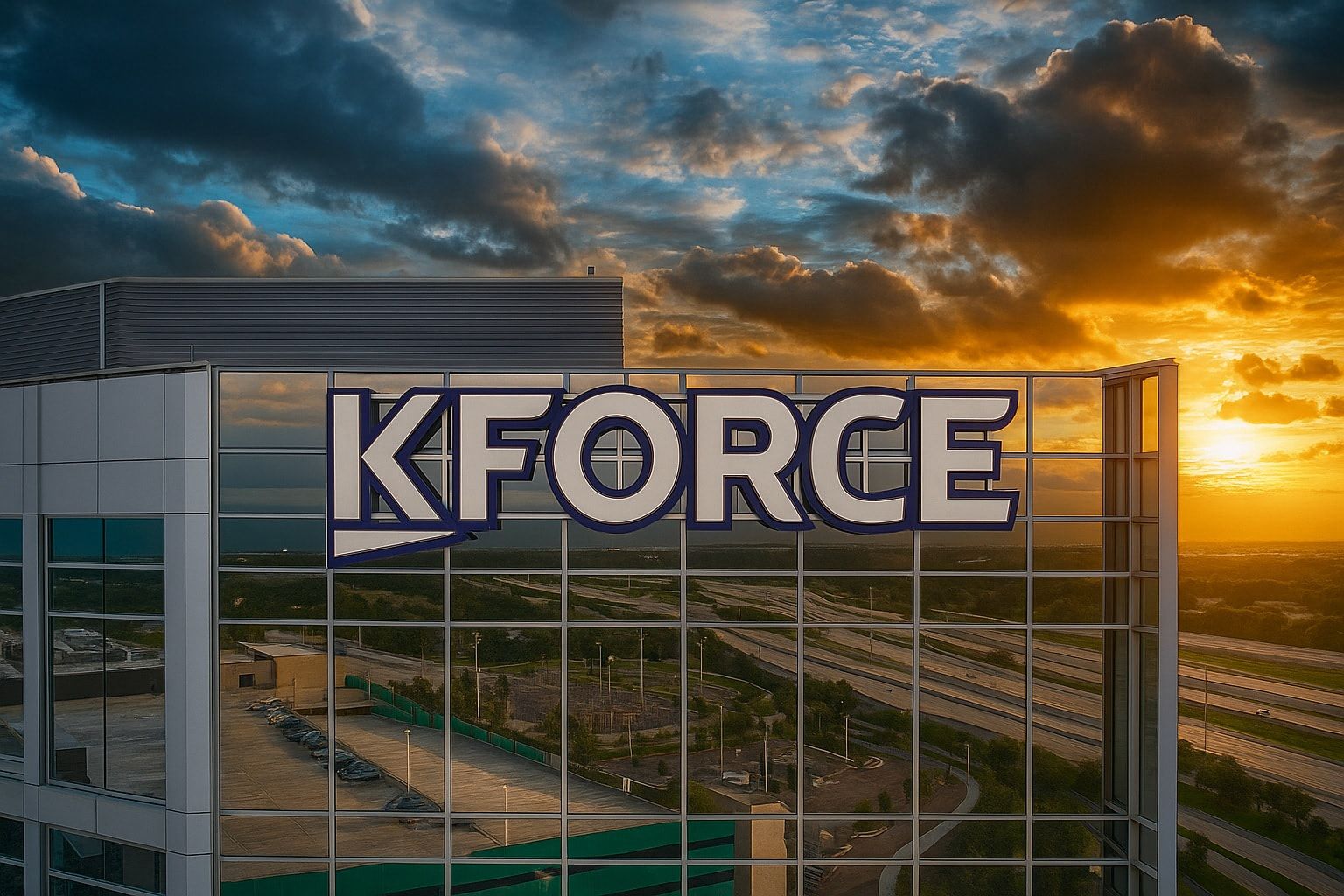- Institutional Buying Spree: Several large investors have recently taken positions in Kforce Inc. (NASDAQ: KFRC). The Teacher Retirement System of Texas boosted its stake by 11.4% in Q2, adding 12,945 shares to hold a total of 126,903 shares (about 0.68% of the company) [1]. Allianz Asset Management GmbH likewise acquired 13,414 Kforce shares (a 0.07% stake valued around $552,000) during Q2 [2]. Other institutional players have also been buying – for example, Jacobs Levy Equity Management purchased 64,616 shares in September [3] and Callan Family Office LLC bought 25,771 shares in October [4] – indicating some “smart money” interest in the stock at current prices.
- Stock at 52-Week Lows: Kforce’s stock price has plunged to new lows in recent weeks amid a broader industry slump. Shares closed around $25.31 on October 31 [5], hovering just above their 52-week low of $24.62 [6] and down roughly 60% from the 12-month high of $62.80 [7]. The stock has shed about 15.9% in the last month alone [8], significantly underperforming the broader professional services sector (which fell ~2.8% in the same period) [9]. At this depressed price, Kforce trades at a modest ~9x earnings (trailing P/E ~9.4 [10]) and offers a rich dividend yield (~6% annually, with a $0.39 quarterly dividend declared for Q3 [11]), reflecting both value potential and market skepticism.
- Q3 Earnings Loom – More Declines Expected: Kforce is scheduled to report its third quarter 2025 earnings on November 3, 2025 after the market close [12]. Analysts forecast another quarter of declining revenue and earnings. Consensus estimates call for Q3 revenue around $327–328 million, which would be a 7% year-over-year drop (accelerating from a 5.3% decline in Q3 last year) [13], and adjusted earnings of roughly $0.56–$0.59 per share [14] [15]. This comes after a “softer” Q2 in which Kforce’s revenue was $334.3 million (–6.2% YoY) and EPS $0.59, slightly missing Wall Street’s expectations [16]. Notably, the company’s guidance issued after Q2 also fell short of analysts’ targets, signaling ongoing headwinds [17]. Over the past two years, Kforce has missed consensus revenue estimates five times, underscoring the challenge of forecasting in its demand-constrained market [18].
- Analysts Turn Cautious – Ratings & Targets Cut: Wall Street sentiment on Kforce has soured amid its underperformance. Zacks Research recently downgraded KFRC from a Hold to a rare “Strong Sell” rating [19], reflecting a bearish view on the company’s near-term prospects. Major brokerages have also slashed their price targets – for example, UBS Group trimmed its target from $45 to $40 (maintaining a Neutral stance) and Truist Financial cut its target from $46 to $35 while reiterating a Hold rating [20]. As of early November, no analysts recommend Kforce as a Buy – the consensus rating is effectively Hold/Reduce, with 2 Holds and 1 Sell [21]. The average price target sits around $37.50 according to MarketBeat data [22] (other sources cite ~$42 [23]), implying potential upside of 50%+ from the current price if the company can get back on track [24]. However, that optimism is tempered by uncertainty; recent target cuts indicate lowered expectations going forward.
- Industry Context – Headwinds and Hints of Stability: Kforce is a specialized staffing and solutions provider focusing on technology and finance/accounting talent. Like many in the professional staffing industry, it’s grappling with a “demand-constrained environment,” especially in tech hiring, as clients remain cautious amid economic uncertainty [25]. Peers’ recent earnings illustrate the headwinds: for Q3, ManpowerGroup managed 2.3% revenue growth (slightly beating forecasts) while Robert Half International saw a 7.5% revenue drop in line with expectations [26]. Yet even good results haven’t impressed investors – Manpower’s stock plunged 11% after its beat, and Robert Half’s dipped ~1% after its report [27]. This suggests a skeptical market mood where any weakness is punished and even in-line performance can lead to sell-offs. On the positive side, Kforce’s management notes that technology staffing demand has stabilized at lower levels and that clients have a “significant backlog of strategically imperative technology investments” ready to roll out once the macro outlook improves [28]. In fact, Kforce achieved sequential growth in both its Tech and Finance segments in Q2 [29] [30], and the CEO expressed confidence that the firm is holding or even gaining market share despite the downturn [31]. The company has also been proactive in supporting its stock – authorizing buybacks (returning $17.4 million to shareholders via repurchases and dividends in Q2 alone) [32] – signaling management’s belief that the shares are undervalued.
Kforce at a Crossroads: Will Q3 Mark a Turning Point?
Kforce’s Steep Slide: It’s been a rough year for Kforce shareholders. The stock has lost well over half its value from its highs as hiring in the tech sector cooled and recession fears weighed on corporate spending. In mid-October, Kforce shares hit a new 12-month low, dipping to about $24.62 [33], after an analyst downgrade added to the pessimism. Even after a modest bounce, the stock is only around the mid-$25 level in early November – a far cry from the $60+ prices seen within the past year [34]. This plunge reflects both company-specific struggles (declining revenues, cautious guidance) and broader market headwinds. As evidence, an index of professional staffing stocks is down only a few percent over the last month, yet Kforce tumbled nearly 16% in that time [35], indicating investors have singled it out for harsher punishment.
Big Investors See Bargain Potential: Interestingly, as the stock cratered, several institutional investors took the opportunity to accumulate shares. The Teacher Retirement System of Texas – a $200+ billion pension fund – disclosed that it boosted its position in Kforce by 11.4% during the second quarter [36]. By quarter’s end, Texas TRS held ~126,900 shares, worth about $5.2 million at that time [37]. Around the same time, Allianz Asset Management, part of the global financial giant Allianz, initiated a new stake of 13,414 shares (worth roughly $552,000) in Kforce [38]. These moves, revealed through recent SEC filings, suggest that some savvy, long-term investors see value in Kforce at these depressed prices. In fact, the buying wasn’t limited to just those two institutions – filings show that Jacobs Levy Equity Management (a respected quant-oriented fund) purchased over 64,000 shares in Kforce late in Q3 [39]. And in mid-October, a family office (Callan Family Office LLC) snapped up 25,771 shares as well [40]. Such cluster buying by institutional players implies contrarian confidence – these investors may believe Kforce’s business will stabilize or rebound, making the current low valuation attractive. It’s worth noting that as of the latest data, over 92% of Kforce’s stock is owned by institutions [41], meaning the stock is closely watched by professional investors.
What’s Hurting Kforce? Kforce provides staffing and consulting services, primarily in technology (IT, software development, data analytics, project management, etc.) and finance & accounting roles [42]. During boom times, demand for tech talent can far outstrip supply – benefiting firms like Kforce that place skilled professionals in client projects. However, the tide has turned since late 2022: many businesses have tightened their belts on hiring, especially for IT projects, due to economic uncertainty, rising interest rates, and in some cases over-hiring during the prior tech boom. Kforce’s financials reflect this cyclical downturn. In the second quarter of 2025, revenue fell 6.2% year-over-year to $334.3 million [43], and earnings per share dropped to $0.59 from $0.75 a year prior [44]. That Q2 revenue actually met analysts’ expectations (and even grew 1.3% sequentially from Q1) [45], but management acknowledged it was a challenging quarter. “It was a softer quarter for the company,” one analyst report noted, with Kforce missing analysts’ guidance for the following quarter as well [46]. In other words, not only has current performance been weak, but Kforce signaled that the near-term future (i.e. Q3) would likely be weaker than what analysts had hoped for. This one-two punch of declining results and cautious forward guidance has weighed heavily on the stock.
Q3 Preview – Further Declines: Now all eyes are on the third quarter 2025 report, which Kforce will release on November 3 after the market close [47]. Expectations aren’t high. Wall Street consensus calls for about $328 million in revenue for Q3, down roughly 7% from the same quarter last year [48]. If that forecast holds, it means Kforce’s top-line contraction is actually worsening (last year’s Q3 saw a ~5.3% drop, so a 7% decline this quarter would be a further deceleration of growth) [49]. On the earnings side, analysts predict around $0.56–$0.59 EPS for Q3 [50], compared to $0.75 in 3Q 2024 – a significant decline year-on-year. Notably, management’s own guidance (issued back in July) was for $324–332 million revenue and $0.53–0.61 EPS in Q3 [51], which brackets the current consensus. This suggests that business trends haven’t dramatically deteriorated beyond what Kforce already signaled, but they remain softer than a year ago. The company’s Tech segment has been the main drag, with year-over-year revenue in that division down mid-single digits in recent quarters [52], while the Finance/Accounting segment saw double-digit declines (partly due to tough comparisons) [53]. The good news is that on a sequential (quarter-to-quarter) basis, Kforce managed to eke out slight growth in both segments in Q2 [54], indicating some stabilization at a lower base. CEO Joseph Liberatore noted that Kforce is “continuing to operate in a demand-constrained environment” – clients are still cautious and scaling back on new initiatives – “yet we remain encouraged by recent trends that continue to affirm the stability in our Technology business.” [55] He highlighted that many clients have critical tech projects on hold due to macroeconomic uncertainty, saying “our clients continue to carry a significant backlog of strategically imperative technology investments that they expect to execute once greater positive visibility exists.” [56] In plain terms, there’s pent-up demand for IT services that could be unleashed if/when the economy (or at least business confidence) improves. For now, though, Kforce has to weather the slump. Investors will be watching the Q3 earnings release for any signs that demand is finally bottoming out – or conversely, any revision to the outlook that suggests further pain ahead.
Peer Performance Signals Caution: Kforce is not alone in facing a softer hiring market. Two of its closest peers – ManpowerGroup (MAN) and Robert Half International (RHI) – have already reported their Q3 results, and the market reaction was telling. ManpowerGroup actually beat expectations with a slight uptick in revenue (+2.3% YoY) [57], yet its stock plunged 11.4% immediately after earnings [58]. Robert Half saw a steep –7.5% decline in revenue (very similar to what’s expected of Kforce) and merely matched analyst forecasts [59]; its stock fell as well, though only by ~1% post-earnings [60]. The harsh response to Manpower’s decent results (and mild response to Robert Half’s weak-but-not-worse-than-expected results) suggests investors have priced in a lot of bad news in this sector already. Any company that even hints at further deterioration can be punished severely. On the flip side, a company that delivers a big positive surprise could see an outsized relief rally, precisely because sentiment is so bearish. This context sets the stage for Kforce’s report – if Kforce can clear the low bar set by expectations (say, by posting a smaller revenue decline or guiding Q4 above current estimates), the stock could get a nice bounce. But if results or commentary disappoint in any way, the downside could still be significant, given the fragile state of the stock. As one financial writer observed about Kforce going into earnings: “Debates over possible tariffs and tax adjustments have raised questions about economic stability in 2025… the [professional services] group has generally underperformed, with share prices down… Kforce is down 15.9%… heading into earnings with an average analyst price target of $42 (compared to the current share price of $25.30)” [61]. In short, the macro clouds hanging over the economy (e.g. policy uncertainty, mixed data, geopolitical issues) are amplifying the cyclical slowdown Kforce is already experiencing.
Analyst Opinions – Mostly Bearish, for Now: The wave of institutional buying might indicate some insiders see a bottom, but equity analysts covering Kforce remain mostly cautious or negative. As mentioned, Zacks Investment Research recently slapped a “Strong Sell” on KFRC [62] – a designation they reserve for cases where they anticipate significant underperformance relative to the market. Meanwhile, the bigger brokerage firms have not issued any Buy ratings lately. UBS has a Neutral rating (downgraded earlier from Buy) and in late July cut its price target to $40 [63], citing the softer outlook. Truist Financial likewise has a Hold on the stock and in mid-October lowered its target to $35 [64], calling the forecast for Kforce “pessimistic” amid the tech staffing slowdown. A recent Benzinga analysis noted that among 4 analysts tracked, zero rated Kforce a Buy, with 3 Hold and 1 Sell rating, and an average target in the high-$30s [65]. According to MarketBeat’s compilation, the consensus rating is now “Reduce” (essentially between a Hold and Sell) and the average target price is about $37.50 per share [66]. That target is roughly 48% above the latest price, implying analysts see considerable upside if business conditions improve – but it’s also down markedly from where targets stood a year ago. In fact, just a year ago Kforce was trading near $60 and many analysts then had targets in the $65–$70 range. The steady parade of target downgrades over 2023–2025 reflects how Kforce’s earnings have underwhelmed. It’s important to note, however, that analyst targets are often 6-12 month projections. The current ~$37–$40 targets do not guarantee a rebound; they simply indicate that if Kforce stabilizes at, say, ~$2.70 in annual EPS (which is the consensus forecast for this year) [67] and can return to modest growth next year, a valuation of around 14–15 times earnings might be warranted (which yields a stock price in the high 30s). For now, those are big “ifs”, and analysts are essentially in wait-and-see mode pending the upcoming earnings and management’s commentary on the outlook.
Value Case vs. Risk – What’s Next for KFRC?: With the stock beaten down and yielding over 6%, is Kforce now a hidden gem or a value trap? The bull case for Kforce rests on a few key points: First, the essential nature of tech talent – companies can only defer critical IT projects for so long before skill shortages bite, and Kforce’s niche in providing specialized tech and finance professionals could mean a swift demand recovery when sentiment turns. Second, Kforce is financially stable with a strong balance sheet (debt-to-equity is only 0.16 [68]) and continues to generate profits and cash. The company has been using that cash to buy back shares and pay dividends, returning capital to shareholders even through the downturn [69]. This shareholder-friendly approach both supports the stock and signals that management sees value in its own shares. Additionally, at ~$25 per share, the stock’s valuation is very low relative to historical levels – its trailing P/E near 9 is well below the market average and even below many slower-growing staffing peers [70]. If the earnings stabilize around current levels, one could argue the downside is limited and the stock might even be oversold. It’s no surprise, then, that contrarian investors like pension funds and quant funds have started nibbling at these levels.
However, the bear case cannot be ignored. The same low valuation could be signaling that the market expects further declines in earnings. If the economy slips into recession or if corporate hiring freezes persist into 2026, Kforce’s revenues could continue shrinking. In a worst-case scenario, even a mild recession might cause a sharper drop in demand for Kforce’s services, pressuring earnings and possibly leading to layoffs or other cost cuts. Another risk is that structural changes (e.g. more companies adopting remote/freelance platforms or AI tools reducing the need for certain staffing services) could be weighing on Kforce’s longer-term outlook, not just cyclical factors. The fact that Kforce’s tech segment is struggling even amid a much-hyped wave of AI and digital transformation projects raises some eyebrows – it could suggest that competitors or alternative staffing models are taking share, or simply that clients are extremely budget-conscious right now. Kforce’s own commentary implies the demand is there but delayed: clients are waiting for “greater visibility” before resuming normal project spending [71]. If that visibility (clarity on the economy) doesn’t materialize, the wait could be long. During that time, Kforce will need to execute well just to maintain its current business and keep expenses in check. The company has already kept its operating margins around 4–5% [72], which is decent given the top-line drop, but any further revenue decline could squeeze margins more.
Earnings Report – Catalyst for a Rebound? The imminent Q3 earnings release will be a critical catalyst for Kforce’s stock. Investors will dissect the results for any sign that the worst is over. Key things to watch include: (1)Revenue trend – did the year-over-year decline moderate or worsen? If Kforce manages a smaller drop than expected (say -5% instead of -7%), that could indicate improvement. (2)Guidance for Q4 – management typically provides some guidance; any outlook suggesting stabilization or growth (even low single digits) in Q4 would be a positive surprise. Conversely, a guide implying double-digit decline would be a red flag. (3)Tech vs F&A segment performance – if the Technology segment returns to year-over-year growth or even flat performance, it would validate the CEO’s optimism about stability there. (4)Bookings or backlog commentary – any qualitative remarks about clients reactivating projects or an increase in job requisitions would be bullish signals. (5)Continued buybacks/dividends – Kforce’s Board has been consistent with dividends; an increase in buyback authorization or accelerated repurchases could indicate they see the stock as significantly undervalued.
Given the low expectations, Kforce doesn’t need to deliver stellar numbers to jolt the stock upward – it may simply need to show that things aren’t getting materially worse. If the company hits the midpoint of its Q3 guidance and sounds a note of cautious optimism for year-end, the stock could see relief. On the other hand, if Q3 comes in weak and the company cites further delays or softness (for instance, if that “backlog” of tech investments still isn’t translating to any new deals), investors may conclude that the pain will extend well into 2026, and shares could languish or slide further.
The Bottom Line: Kforce is a classic contrarian opportunity right now – cheap, disliked, and at a crossroads where news flow in the next few days/weeks will heavily influence its trajectory. Big institutional buyers clearly are betting on a turnaround, taking advantage of the pessimism to accumulate shares [73] [74]. The stock’s fundamentals (low P/E, high yield, low debt) provide a margin of safety, but only up to a point; fundamentals won’t matter if the core business continues shrinking. For the average investor, the risk-reward at this juncture hinges on one’s outlook for the U.S. economy and IT spending. If you believe that economic visibility will improve in 2026 and companies will ramp up their tech projects again, then Kforce at $25 looks tantalizing – potentially offering significant upside (analysts’ targets in the high-$30s or $40+ imply 40–60% gains) [75] [76]. Plus, you’d get paid a solid dividend while you wait. However, if you suspect that hiring freezes and IT budget cuts will persist or worsen, then it’s safer to heed the analysts’ warnings and perhaps stay on the sidelines until there are clearer signs of a turnaround. As of now, experts are mixed: the company’s CEO strikes an optimistic tone about “stable demand” and future opportunities [77], but independent analysts remain guarded, with at least one outright sell rating on the stock [78].
All told, Kforce’s Q3 report and commentary will be pivotal. It could mark the beginning of a comeback for this beaten-down stock – or confirm investors’ worst fears. Keep an eye on November 3rd’s earnings announcement; it may very well answer the looming question on every stakeholder’s mind: Has Kforce hit bottom, or is there more downside ahead? [79] [80]
Sources: Kforce Q3 Earnings Preview (StockStory/Yahoo) [81] [82]; MarketBeat Instant Alerts [83] [84] [85]; Kforce Investor Relations (press release and SEC filings) [86] [87]; Peer company reports [88].
References
1. www.marketbeat.com, 2. www.marketbeat.com, 3. www.marketbeat.com, 4. www.marketbeat.com, 5. www.marketbeat.com, 6. www.marketbeat.com, 7. www.marketbeat.com, 8. www.indexbox.io, 9. www.indexbox.io, 10. www.marketbeat.com, 11. investor.kforce.com, 12. finviz.com, 13. www.indexbox.io, 14. finance.yahoo.com, 15. www.indexbox.io, 16. www.marketbeat.com, 17. finviz.com, 18. finviz.com, 19. www.marketbeat.com, 20. www.marketbeat.com, 21. www.marketbeat.com, 22. www.marketbeat.com, 23. finviz.com, 24. finviz.com, 25. investor.kforce.com, 26. www.indexbox.io, 27. www.indexbox.io, 28. investor.kforce.com, 29. investor.kforce.com, 30. investor.kforce.com, 31. investor.kforce.com, 32. investor.kforce.com, 33. www.marketbeat.com, 34. www.marketbeat.com, 35. www.indexbox.io, 36. www.marketbeat.com, 37. www.marketbeat.com, 38. www.marketbeat.com, 39. www.marketbeat.com, 40. www.marketbeat.com, 41. www.marketbeat.com, 42. www.marketbeat.com, 43. www.marketbeat.com, 44. www.marketbeat.com, 45. investor.kforce.com, 46. finviz.com, 47. finviz.com, 48. www.indexbox.io, 49. www.indexbox.io, 50. finance.yahoo.com, 51. investor.kforce.com, 52. investor.kforce.com, 53. investor.kforce.com, 54. investor.kforce.com, 55. investor.kforce.com, 56. investor.kforce.com, 57. www.indexbox.io, 58. www.indexbox.io, 59. www.indexbox.io, 60. www.indexbox.io, 61. finviz.com, 62. www.marketbeat.com, 63. www.marketbeat.com, 64. www.marketbeat.com, 65. www.marketbeat.com, 66. www.marketbeat.com, 67. www.marketbeat.com, 68. www.marketbeat.com, 69. investor.kforce.com, 70. www.marketbeat.com, 71. investor.kforce.com, 72. investor.kforce.com, 73. www.marketbeat.com, 74. www.marketbeat.com, 75. www.marketbeat.com, 76. finviz.com, 77. investor.kforce.com, 78. www.marketbeat.com, 79. finviz.com, 80. www.marketbeat.com, 81. www.indexbox.io, 82. www.indexbox.io, 83. www.marketbeat.com, 84. www.marketbeat.com, 85. www.marketbeat.com, 86. investor.kforce.com, 87. investor.kforce.com, 88. www.indexbox.io





